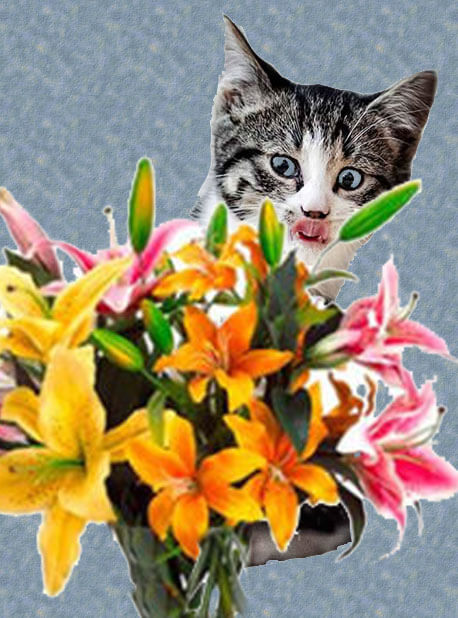
After a long and dreary winter, it is finally spring and beautiful flowers are blooming everywhere. Whether picking out houseplants for your home, or choosing a bouquet for your mom on Mother’s Day, pay special attention to the types of plants you select. Although often overlooked, many common decorative plant species are toxic to pets. One of the more popular flowers this time of year, lilies, are very poisonous to cats.
Common Lily Varieties:
All plants in the Lilium or Hemerocallis genus should be considered toxic to cats, and should be avoided in any area that your feline family member has access. Common plants in this group include:
- Easter lily (Lilium longiflorum)
- Tiger lily (Lilium lancifolium)
- Asian lily (Lilium asiatica)
- Stargazer lily (Lilium auratum)
- Japanese lily (Lilium speciosum)
- Daylily (Hemerocallis spp.)
Even a small amount can be toxic.
Sometimes, despite our best efforts, our rambunctious cats can get into almost anything we try to keep them out of. Knowing the signs of lily poisoning can help you identify a problem, so that you can bring your cat to your vet for treatment as soon as possible.
Toxicity occurs when a cat ingests any part of a lily, including just a small portion of the plant or even just the pollen. Usually, clinical signs will occur within twelve hours of ingestion, but can occur as early as two hours after consumption, or as far out as five days.
Symptoms to know:
If you fear that your cat may have eaten part of a lily, early signs of lily toxicity can include:
- vomiting
- decreased appetite/anorexia
- decreased energy level
The more serious signs of kidney failure can occur 24 to 72 hours after ingestion.
Increased thirst and increased urination are often early signs of kidney failure.
Occasionally, lily ingestion can cause:
- excessive drooling
- tremors
- ataxia
- weakness
- seizures
Treatment:
If you believe that your cat has ingested part of a lily, it is very important to start treatment as soon as possible. When consumption is recent, your veterinarian can start decontamination procedures. First, vomiting is induced to remove the bulk of plant material consumed. Then, activated charcoal, which binds to toxins, is introduced into the stomach to prevent further ingestion of poison into the bloodstream. Finally, IV fluids are started to flush out the system, and continued for a minimum of 48 to 72 hours for kidney support.
But my cat seems fine!
When consumption of lilies is suspected, treatment should be started even if your cat is not showing any clinical signs of toxicity. The earlier medical treatment begins, the more likely it will be successful. Waiting until the presentation of kidney failure symptoms to seek medical intervention greatly increases risks. Lily ingestion can be fatal (usually 3-7days post exposure), if no treatment is pursued.
Avoiding interactions between your cat family and lilies, and quickly seeking veterinary assistance when consumption may be a possibility, can keep your cats safe during the long-awaited spring.
Catherine Gamber, DVM
Queen Anne Animal Clinic
